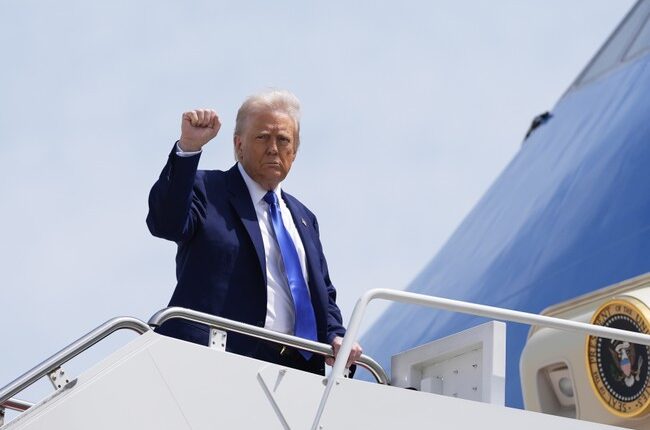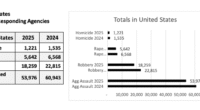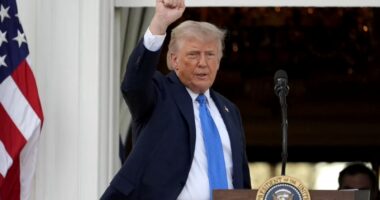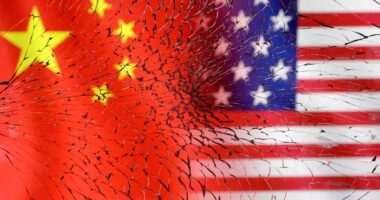
President Donald Trump embarked on a four-day visit to the Middle East on Monday, with the goal of enhancing economic partnerships, advancing diplomatic efforts, and promoting stability in the region. This trip, the first state visit of his second term, demonstrates a renewed dedication to building alliances that benefit both the United States and its allies in the Middle East. Trump’s focus on fostering economic growth, cultural exchanges, and combatting extremism through cooperation presents a positive outlook for a prosperous and secure future.
Air Force One with President Trump 🇺🇸escorted by fighter jets over Saudi Arabia 🇸🇦
All the rest of the world’s air forces holding the beer 🍺pic.twitter.com/hBEZh3xiOP
— Mambo Italiano (@mamboitaliano__) May 13, 2025
The journey kicked off in Riyadh, Saudi Arabia, on Tuesday, where Trump is scheduled to meet with Crown Prince Mohammed bin Salman, the dynamic leader of the kingdom. This visit recalls Trump’s inaugural foreign trip as president in 2017, when he chose Saudi Arabia as his first destination. White House Press Secretary Karoline Leavitt characterized the visit as a “historic return,” emphasizing Trump’s vision for a Middle East characterized by prosperity and collaboration. Leavitt stated, “This journey highlights the imminent golden age for both America and the Middle East, bonded by a joint vision of stability, opportunities, and mutual respect.”
Wednesday will see Trump participating in a notable summit of Gulf leaders in Riyadh, with the presence of top executives from prominent American companies like IBM, BlackRock, Palantir, Citigroup, Qualcomm, Alphabet, and Franklin Templeton. The participation of these corporate giants underscores the trip’s economic emphasis, with expectations of new agreements solidifying ties between the U.S. and the region. Following this summit, Trump will visit U.S. service members at a key air base in Qatar, demonstrating appreciation for their dedication and reinforcing the United States’ commitment to its military presence overseas. The tour is set to conclude in the United Arab Emirates on Thursday, with further agreements on the horizon.
BOOM: Trump lands in Saudi Arabia like a lion—no bending, no begging.
The days of America being laughed at are OVER.
Stand tall. 🔥
Protect the man who put us first. 🇺🇸
Thoughts? ⬇️ pic.twitter.com/ncIQPbsabe
— Tony Lane 🇺🇸 (@TonyLaneNV) May 13, 2025
At the heart of Trump’s “America First” agenda are economic partnerships that promise significant investments in the U.S. economy. Saudi Arabia has pledged $600 billion over the next four years, while the UAE has committed an impressive $1.4 trillion over the next decade. These investments are expected to create jobs and drive innovation in the U.S., while fostering joint ventures and boosting American exports, including advanced weaponry and technology. Saudi commentator Ali Shihabi highlighted the potential for these deals to “further integrate the Saudi and U.S. economies together,” creating opportunities for both nations.
The trip also carries diplomatic weight, with efforts to advance a Gaza cease-fire high on the agenda. Just a day ago, Hamas released 21-year-old Edan Alexander, a dual U.S.-Israeli citizen and the last known living American hostage held in Gaza, marking a positive step forward. While Trump will not meet with Israeli Prime Minister Benjamin Netanyahu during this tour, his administration is actively engaged in regional diplomacy. On Sunday, Trump’s Middle East envoy, Steve Witkoff, held critical talks with Iran, signaling a pragmatic approach to easing tensions. Gulf nations, wary of conflict with Iran, have expressed cautious optimism about these negotiations, according to Jon Alterman of the Center for Strategic and International Studies.
.@POTUS is greeted by Crown Prince Mohammed bin Salman in Riyadh, Saudi Arabia 🇺🇸🇸🇦 pic.twitter.com/81qUv6hi7D
— Rapid Response 47 (@RapidResponse47) May 13, 2025
Trump has made clear that he seeks a peaceful resolution with Iran but has warned of consequences if diplomacy fails. This balanced approach—firm yet open to dialogue—reflects his broader strategy of promoting stability while protecting American interests.
As President Trump engages with Middle Eastern leaders, his trip symbolizes a renewed American optimism about the region’s potential. By prioritizing economic partnerships, honoring U.S. service members, and pursuing peace, the president is laying the groundwork for a future where America and its allies prosper together. With billions in investments and a commitment to cooperation, this tour could mark a turning point in U.S.-Middle East relations, fostering a brighter, more interconnected tomorrow.
















